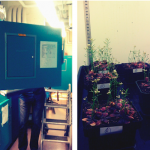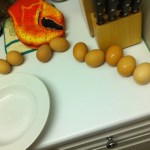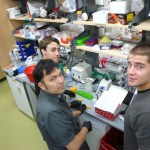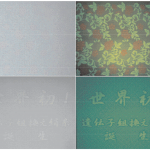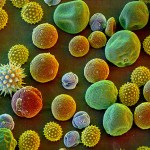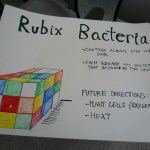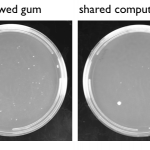experiment
Back in July, I did a post looking at how the fountain in our ornamental backyard pond shoots higher when the level of the pond drops. I set up a simple model of the process, which worked surprisingly well, but I said at the time that I really needed more data to say whether that agreement was real or accidental. Well, yesterday, I got some extreme data:
The leak in the pond has gotten worse, I think, and the water was barely covering the top of the pump box at all. A very rough calibration of this image, using the fact that the brick is 2in high, gives a height of the spray of about 62in,…
Sometimes among all of the tedious protocols and mundane inconclusive data, I forget that I'm doing something amazing and incredibly powerful. Almost all my experiments require altering a living organism to do my bidding--to hold onto and replicate a piece of DNA that I'm interested in or to produce an enzyme that I want a lot of. Thanks to iGEM this summer I've gotten to learn some new soon-to-be-tedious protocols that seem absolutely thrilling now, and the experience is reminding me of how awesome (in the real sense of the word) genetic engineering is.
The team is working with the model…
There's a minor scandal in fundamental physics that doesn't get talked about much, and it has to do with the very first fundamental force discovered, gravity. The scandal is the value of Newton's gravitational constant G, which is the least well known of the fundamental constants, with a value of 6.674 28(67) x 10-11 m3 kg-1 s-2. That may seem pretty precise, but the uncertainty (the two digits in parentheses) is scandalously large when compared to something like Planck's constant at 6.626 068 96(33) x 10-34 J s. (You can look up the official values of your favorite fundamental constants at…
The Joerg Heber post that provided one of the two papers for yesterday's Hanbury Brown Twiss-travaganza also included a write-up of a new paper in Nature on Mott insulators, which was also written up in Physics World.
Most of the experimental details are quite similar to a paper by Markus Greiner's group I wrote up in June: They make a Bose-Einstein Condensate, load it into an optical lattice, and use a fancy lens system to detect individual atoms at sites of the lattice. This lattice can be prepared in a "Mott insulator" state, where each site is occupied by a definite number of atoms. As…
Two papers in one post this time out. One of these was brought to my attention by Joerg Heber, the other I was reminded of when checking some information for last week's mathematical post on photons. They fit extremely well together though, and both relate to the photon correlation stuff I was talking about last week.
OK, what's the deal with these? These are two papers, one recent Optics Express paper from a week or so ago, the other a Nature article from a few years back. The Nature paper includes the graph you see at right, which is a really nice dataset demonstrating the Hanbury Brown and…
Last week's series of posts on the hardware needed for laser cooling and trapping experiments dealt specifically with laser-cooling type experiments. It's possible, though, to make cold atoms without using laser cooling, using a number of techniques I described in two posts back in January. Those didn't go into the hardware required, though, so what's different about those techniques in terms of the gear?
Less than you might think. In fact, most of the labs that do these experiments use exactly the same sorts of equipment that laser coolers do. Including some lasers.
It's not all of them, but…
The third category in our look at lab apparatus, after vacuum hardware and lasers and optics is the huge collection of electronic gear that we use to control the experiments. I'll borrow the sales term "test and measurement" as a catch-all description, though this is really broader than what you'll usually find in that category.
This category covers all sorts of stuff, from power supplies to data acquisition equipment, but we'll start with the oscilloscopes.
The picture above shows two of the many oscilloscopes that rattle around my lab. These are used for almost everything that involves a…
Following on yesterday's discussion of the vacuum hardware needed for cooling atoms, let's talk about the other main component of the apparatus: the optical system. The primary technique used for making cold atoms is laser cooling, and I'm sure it will come as no surprise that this requires lasers, and where there are lasers, there must also be optics.
There are lots of different types of lasers used for laser cooling experiments, but they all need to have certain properties: tunability, stability, and adequate power. Tunability is important because laser cooling requires light at exactly…
Over in the reader request thread, Richard asks for experimental details:
I'd be interested in (probably a series) of posts on how people practically actually do cold atoms experiments because I don't really know.
I needed to take some new publicity photos of the lab anyway, so this is a good excuse to bust out some image-heavy posts-- lab porn, if you will. There are a lot of different components that go into making a cold-atom experiment, so we'll break this down by subsystems, starting with the most photogenic of them, the vacuum system:
(Click on that for a much bigger version.)
This…
It turns out that my wonderful iGEM students, besides being brilliant scientists, are also excellent, hilarious actors. Please enjoy their Jersey Shore inspired video about molecular cloning:
Back at the start of the summer, I asked a question about automotive thermodynamics: On a hot day, is it better to open your car windows a crack when making a short stop, or leave them closed? For a long term-- say, leaving your car parked outside all day-- I hope everyone will agree that leaving the windows slightly open is the better call, but the answer isn't as clear for a short stop. There might well be some time during which the open-window car heats up faster as warm air from outside gets in, while the closed-window car holds in the air-conditioned goodness longer.
It occurred to me…
When one of the most recent issues of Physical Review Letters hit my inbox, I immediately flagged these two papers as something to write up for ResearchBlogging. This I looked at the accompanying viewpoint in Physics, and discovered that Chris Westbrook already did most of the work for me. And, as a bonus, you can get free PDF's of the two articles from the Physics link, in case you want to follow along at home.
Since I spent a little time thinking about these already, though, and because it connects to the question of electron spin that I talked about yesterday, I think it's still worth…
In the comments following the silly accelerator poll, onymous wrote:
[T]he point of the LHC isn't to discover the Higgs. No one in their right minds would build a 14 TeV pp collider if their only goal was to discover the Higgs.
While it's true that the ultimate goal of the LHC is to discover more exotic particles that may or may not exist (blah, blah, supersymmetry, blah) most of the hype has focussed on the Higgs, which is the one thing they're pretty sure they'll find (comments later in that thread notwithstanding). This is one of the potential problems with the way the machine has been…
Science is cooking done in a lab. Mixing carefully (or not so carefully) measured components, heating, cooling, observing phase transitions, exploring the behavior of animal and plant proteins, exploring the properties of different chemicals, slowly changing variables to optimizing procedures. Often, feeding bacteria has a lot in common with feeding people, and I have to admit that freshly autoclaved yeast media smells delicious.
Said another way, cooking is science where at least you can usually eat the failures. My fiancé and I have been failing at making soft-boiled eggs for quite some…
Last week, Dmitry Budker's group at Berkeley published a paper in Physical Review Letters (also free on the arxiv) with the somewhat drab title "Spectroscopic Test of Bose-Einsten Statistics for Photons." Honestly, I probably wouldn't've noticed it, even though this is the sort of precision AMO test of physics that I love, had it not been for the awesome press release Berkeley put together, and this image in particular (grabbed with its caption):
This is a nifty paper, and deserves a little explanation in Q&A format:
Is this another New Scientist style "Einstein was wrong" paper? No. If…
The first (and sometimes 3rd, 12th, 25th, 134th...) step of any genetic engineering experiment is often extracting DNA from some organism or another. While novel gene synthesis technology will likely make this procedure obsolete, these days it's still most economical to do it by hand. Extracting DNA from fruits like strawberries has also seen a popular resurgence thanks to groups like DIYbio, with instructions for making DNA shots available online for a fun and nerdy party activity. Today my iGEM team extracted RNA from strawberries and oranges to isolate the genes responsible for strawberry…
Silk is an amazing biomaterial, cultivated and prized for more than 5,000 years. The silk threads that we weave into our shiny fabrics are actually enormous protein crystals produced by insects. This industrial silk that you can buy at the mall is made by silkworms, which use the silk to form the cocoon that protects them as they transform into moths. Many other species of insect also produce silk proteins to protect themselves or their eggs, get around, or catch their prey, but none in such enormous quantity in such easy to harvest packages as the silkworm. Silks from different species are…
A recent New York Times article tells us that what many people call food allergies are actually simple intolerances, and that allergies are being dangerously overdiagnosed. What is a true food allergy, and what can be done to fix them besides banning peanuts from schools and avoiding foods that make us itchy?
Allergies are caused by an inappropriate immune response to common things in the environment. Usually the offending allergen is a protein that comes from plants or animals like pollen or dander. Instead of the immune system recognizing that these proteins are harmless, it instead…
I've been co-teaching a short class on synthetic biology this spring through the MIT High School Studies Program (HSSP). The program is awesome, I took classes through a similar MIT program as a nerdy middle schooler and have had a great time teaching the past few weeks (if you're in the Boston area I highly recommend checking it out as a student or as a volunteer teacher!). My students were terrific--smart, open to new and crazy ideas, thoughtful about bioethics issues, and enthusiastic about thinking about what biology can do and designing new biological species.
Today was our last day of…
The past few days I've been learning a lot about the bacteria that surround me and realizing just how labor intensive an actually well-controlled handwashing experiment can be! Here is a little bit more of the data I've collected about bacteria on everyday objects:
Dusty corners (unsurprisingly?) have the most bacteria, followed by chewed gum, then pens and computer mice. These data also show that the medium of bacterial transmission has a huge effect on what shows up on the plate. Leaving the actual object on the plate--in this case a dust bunny--allows for a lot of bacterial transfer, as…
